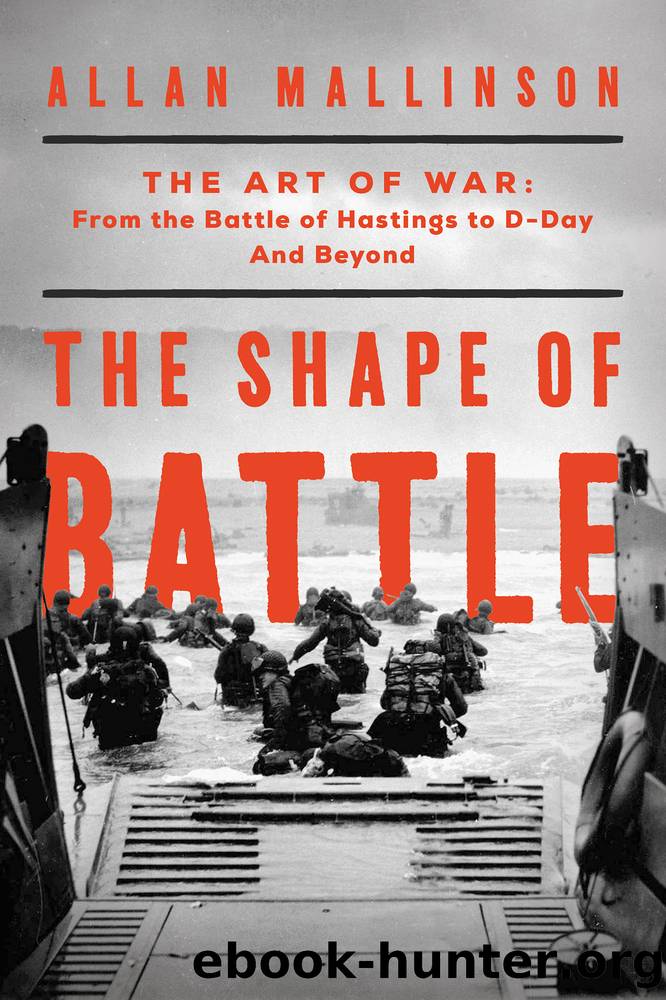The Shape of Battle by Allan Mallinson

Author:Allan Mallinson
Language: eng
Format: epub
Publisher: Pegasus Books
Published: 2022-08-02T00:00:00+00:00
This necessity â being prepared to beat off a tank attack that afternoon or evening â became the dominating factor in the 3rd Divisionâs planning, as indeed in that of the 3rd (Canadian) Division on the right, I Corpsâ other assault division. Whatever their progress inland, therefore, be it promisingly deep or frustratingly shallow, the division had to be able to hold on to its gains that evening. It simply couldnât risk being thrown back into the sea. The I Corps plan â its mission as given to it by 2nd Army â was âto secure, on D Day [emphasis added], a covering position on the general line PUTOT EN BESSIN 9072 â CAEN 0068 â thence R ORNE to the sea, preparatory to a further advance in accordance with the Second Army planâ. And for this advance, 2nd Army needed to get its two remaining corps quickly ashore in the following days.
The 3rd Divisionâs battlefield was now neatly shaped: a triangle tapering towards Caen, some 9 miles at its base (the coast) and 11 long, its left side the Orne (although the division would push its left boundary beyond the river for security), and its right the railway line from Langrune-sur-Mer to La Délivrande and thence to Caen.
The development of the several plans â at army, corps, division and brigade level â was unusually collaborative. âUnusuallyâ because there was time for commanders to discuss things, rather than simply the cascading of orders that active operations usually demand. And also because the dispositions in Britain were imaginative and favourable. The assault divisions of 2nd Army â 3rd British, 3rd Canadian and 50th Northumbrian (Tyne-Tees) â had each been allocated a primary training area. The 3rd British Divisionâs was in the north of Scotland, with headquarters in Cameron Barracks, Inverness. Theyâd been there since the summer of 1943, and in late autumn and early winter were joined by other elements of âAssault Force Sâ, as those earmarked for Sword Beach were known â in particular, specialist armour from 79th Division.
In summer thereâs no finer place than Nairnshire and Ross and Cromarty. The Moray Firth was ideal, too, for practising assault landings, not just for the landing craft but for Hobartâs âfunniesâ, especially the DD tanks. The beaches, too, were similar to Normandyâs. In winter, however, the north of Scotland is short of both daylight and good weather (though freer of fog than England), but is at least a long way from prying eyes. Rennie himself arrived at Inverness on Christmas Day.
From December to May, the 3rd Division took part in seven major exercises. To begin with, these practised assaulting with âtwo upâ â two brigades side by side, and the third in reserve; or rather, in depth, for they would have specific objectives beyond the beach. After Exercise âCrownâ in early February, however, with the actual beaches now earmarked, although known to only a very few in divisional headquarters and the brigadiers, Rennie changed plan. On Exercise âAnchorâ at the end
Download
This site does not store any files on its server. We only index and link to content provided by other sites. Please contact the content providers to delete copyright contents if any and email us, we'll remove relevant links or contents immediately.
| Biological & Chemical | Conventional |
| Nuclear |
The Radium Girls by Kate Moore(11921)
100 Deadly Skills by Clint Emerson(4840)
Rise and Kill First by Ronen Bergman(4701)
The Templars by Dan Jones(4627)
The Doomsday Machine by Daniel Ellsberg(4415)
The Rape of Nanking by Iris Chang(4136)
Killing England by Bill O'Reilly(3951)
Hitler in Los Angeles by Steven J. Ross(3900)
Stalin by Stephen Kotkin(3875)
12 Strong by Doug Stanton(3508)
Hitler's Monsters by Eric Kurlander(3268)
Blood and Sand by Alex Von Tunzelmann(3138)
The Code Book by Simon Singh(3073)
Darkest Hour by Anthony McCarten(3070)
The Art of War Visualized by Jessica Hagy(2943)
Hitler's Flying Saucers: A Guide to German Flying Discs of the Second World War by Stevens Henry(2714)
Babylon's Ark by Lawrence Anthony(2620)
The Second World Wars by Victor Davis Hanson(2479)
Tobruk by Peter Fitzsimons(2442)
